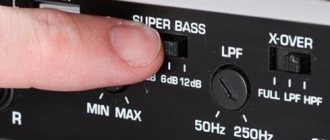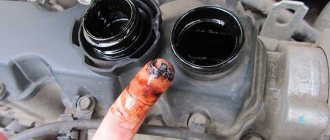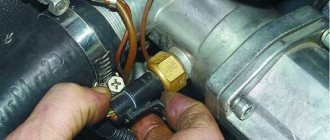Problem with temperature readings on dashboard
#1 vaz152004
- New
- 1 messages
- Car make: VAZ 2115
Recently I encountered such a problem; the temperature on the dashboard began to show 130 degrees.
To solve this problem: – changed the thermostat – changed 2 temperature sensors (which are 1 contact and 2x), one of them on the head of the unit, the other next to the thermostat. But the problem still remained, I did diagnostics on the computer and the computer shows 105 degrees, and on the dashboard 130. Moreover, this arrow rises when you turn on the fan, light and all the electronics. And the temperature will jump to 130 when standing in a traffic jam.
What is causing this problem?
Car: VAZ 2115 Age: 7 years Mileage: 98,000 km
#2 max52
I’m kind and fluffy, but if it’s bad, I’ll kill you.
- Car make: crocodile 21312 / Gazelle 330232
- From: Nizhny Novgorod
View Garage
bad ground on dashboard.
#3 Sashka
Don't swear at the rascal!
- Car make: was VAZ 21083i, now 21134
- From: Sredneuralsk
Post edited by Sashke: September 30, 2011 – 12:58
#4 Nighttrain
- Car make: 21130
- From: Russia
in general, the temperature arrow on the dashboard reaches 90 degrees, after some time it drops to about 80-85, sharply, then it seems to be trying to jerk back but cannot, it started suddenly, if you turn it off and start it, the arrow is in its place, but then it all starts again. What do you recommend, the mass on the engine (for the ECU) and the body next to the Akum is normal, I don’t know where else the mass is in 8k, I thought there was something wrong with the terminal on the sensor, but no, I changed the same thing, tell me, can the sensor itself be made like this? car injector 8ka I heard there is also some kind of mass somewhere in the cabin somewhere under the steering column cover, is that it? If possible, with a picture of where exactly)
- Sasha likes it
#5 Sashka
Don't swear at the rascal!
- Car make: was VAZ 21083i, now 21134
- From: Sredneuralsk
Post edited by Sashke: September 30, 2011 – 01:39
The engine temperature does not rise: what should the driver do?
While operating a vehicle, the driver often has to deal with various failures and malfunctions. At the same time, the most serious are rightly considered to be breakdowns directly related to the engine, gearbox, steering, brake system and chassis.
If we talk about the power unit, in addition to knocks and noises, a violation of the operating temperature regime is a rather serious problem. As a rule, drivers are well aware of the dangers of engine overheating.
However, in a number of cases, it also happens that the engine remains cold, the engine temperature does not rise, or the power unit is warmed up, but according to the temperature gauge the temperature arrow does not rise. Let's look at this malfunction in more detail.
The temperature needle jumps when the thermostat and DTOZh are working
In some cases, it happens that the thermostat, as well as the temperature sensor and wiring, turn out to be working. In this case, the temperature arrow jumps arbitrarily, overestimating or underestimating the readings, in an arbitrary range.
Often the problem lies in the electronic board of the instrument panel. If the soldering of such a board turns out to be of poor quality, problems arise after a few years. The malfunction can be eliminated by disassembling the shield and re-soldering. As part of such work, special attention should be paid to resistors and output mass. If you plan to do the work yourself, you need to have a low-power soldering iron with a thin rod.
As a result, the sensor reacts to changes in temperature, the pointer arrow changes position chaotically. At the same time, the air in the system is indirectly indicated by the fact that liquid is leaking from under the cap of the expansion tank, there may be a noticeable decrease in the level in the tank, etc.
The engine temperature gauge does not rise: why is it dangerous?
Let's start with the fact that normally the temperature of many internal combustion engines after warming up should not exceed, on average, 90 degrees. This temperature regime is optimal. Slight fluctuations of the needle are also allowed if the car is stuck in a traffic jam in the heat or is moving along the highway at high speed in severe frosts.
In the first case, the temperature may rise briefly (usually before the cooling fan turns on). In the second, cold air cools the radiator too intensively, as a result of which the engine cannot fully reach operating temperature.
One way or another, if the temperature needle or digital indicator does not show heating up to 90 degrees even after a long drive, this indicates certain violations of the temperature regime.
It is important to understand that troubleshooting in this case must be done as soon as possible, since operating the engine in underheating mode disrupts the combustion processes of the fuel-air mixture, increases exhaust toxicity and leads to accelerated wear of power plant parts.
In a nutshell, on injection cars, the ECU records the engine temperature, and the engine is determined by the block as cold. As a result, the “brains” enrich the mixture. Working with an over-enriched mixture leads to the formation of carbon deposits, the spark plugs become dirty, the combustion chamber becomes coked, etc.
The engine temperature arrow does not rise: reasons
So, if the driver notices that when driving the engine does not warm up to operating temperature, it is necessary to check the cooling system. Typically, diagnostics of its elements allows you to determine why the engine temperature does not rise.
You should start with tightness. As a rule, insufficiently tightened clamps on the pipes lead to air leaks and the formation of air locks in the cooling system. Also, antifreeze or antifreeze can leak through leaks or defects in tubes and pipes, which leads to a decrease in its level in the expansion tank.
- The next element is the thermostat. In short, this is a device that passes coolant after it has warmed up from a small circle to a large one. The large circle involves circulation through the cooling radiator, and the small circle involves coolant circulation only through the cooling jacket (channels in the cylinder block and cylinder head).
When you turn on the heater, the engine temperature drops
As we said above, turning on the interior heater can affect the engine temperature. In short, many cars have a so-called heater radiator. The specified radiator is included in the general circuit of the engine cooling system, that is, the coolant heated from the engine passes through the radiator, giving off heat. The resulting heat then enters the car interior through the air deflectors. The intensity of heat extraction from the radiator is regulated by the speed of the heater fan and the position of the temperature regulator of the air supplied to the cabin.
For better heating of the interior and internal combustion engine, as well as complete warming up of the gearbox, it is enough to drive the car for several kilometers at medium speed (about 3-3.5 thousand rpm) in a low gear. Also, many drivers use the method of additional insulation of the engine compartment using felt, installing a cardboard or plastic damper on the radiator, etc.
This decision to insulate the engine for the winter is fully justified in cases where the car is operated in conditions of intense cold for a significant part of the time. With additional insulation of the hood and the engine itself, the engine does not cool down so quickly after stopping and warms up faster at idle and while driving. Consequently, the stove in the cabin also works better.
Finally, we would like to add that the quality operation of the entire cooling system depends on antifreeze/antifreeze and its quantity in the system. For this reason, it is necessary to monitor the condition of the coolant and regularly check the fluid level in the expansion tank. You should also monitor the tightness, avoid the formation of air locks, change antifreeze in a timely manner and flush the engine cooling system when replacing the working fluid.
What's the result?
As you can see, there are a number of reasons why the temperature gauge does not rise and/or the engine does not reach operating temperature. At the same time, many drivers are concerned about the question of whether it is possible to drive if the engine does not heat up.
Also, the car may lose performance, fuel consumption increases, loaded components wear out more, engine oil ages faster, exhaust becomes more toxic, the service life of the catalyst decreases, etc.
It is quite obvious that in such a case it is necessary to stop active operation of the vehicle, not to subject the engine to loads, and also to carry out diagnostics and eliminate the malfunction at the first such opportunity.
The engine temperature does not rise, the internal combustion engine temperature needle drops while driving. Why does the temperature drop after turning on the stove? Diagnostics and repair, advice.
The engine does not reach operating temperature, the engine temperature arrow does not rise during warm-up or falls while driving: causes of the malfunction.
The engine warms up slowly at idle or while driving: why does this happen? Possible malfunctions of the cooling system, other reasons.
The engine temperature arrow jumps or jumps chaotically: the main reasons for this malfunction. Diagnosis of problems with your own hands, recommendations.
To warm up or not to warm up the engine in winter before driving. Why the engine should be warmed up, how to properly warm up the engine before driving and while driving.
What temperature of the coolant (antifreeze, antifreeze) is normal on a warm engine. What affects the boiling point and other properties of the coolant.
The engine temperature arrow jumps, floats or jumps: causes and main malfunctions
So, normally the needle should rise to a certain value after the internal combustion engine has completely warmed up and not deviate from its occupied position. Note that during driving, small deviations are quite acceptable, and often to a lesser extent.
This phenomenon usually occurs in the cold season, often when driving on the highway. This is explained by the fact that in cold weather the engine is intensively cooled at high speed by counter flows of cold air.
Also, the heater takes away some of the heat from the engine in winter. As a result, the arrow may “fall” a little (by 2-3 mm from normal values). If you reduce the speed or allow the car to run at idle for several minutes, then the temperature gauge will rise to normal.
- First, in order to understand why the engine temperature gauge needle jumps, it should be taken into account that changing readings on the indicator do not always mean that in reality such significant changes in the temperature of the internal combustion engine occur.
In other words, a change in readings within the average range of 75-95 degrees does not reflect the actual picture, since heated coolant (antifreeze, antifreeze) cannot heat up and cool down so quickly. It turns out that the indicator does not display the actual engine temperature.
Otherwise, a smooth change in readings can be taken as the norm, making allowances for the conventional error of the dial or digital indicator itself. Moreover, if temperature fluctuations do not exceed acceptable limits, it is likely that this is the operating temperature of the engine.
A cause for concern is chaotic, usually sharp fluctuations of the needle, and the amplitude of such fluctuations is quite large. In this situation, it is necessary to determine whether there really is a violation of the thermal balance, whether the indicator itself is working normally, and also for what reasons the malfunction occurred.
- So, let's go. If the system is sealed and the coolant level in the expansion tank is normal, then the most frequently failing element, on which the engine temperature directly depends, is the cooling system thermostat. Moreover, this device often fails even on completely new cars with minimal mileage. So it’s better to start checking with the thermostat.
In practice, this manifests itself as follows: when the driver first warms up the engine, the temperature needle rises to operating temperatures, then the thermostat opens. Next, the coolant flows in a large circle, the engine temperature decreases, but then the thermostat jams and does not close completely.
The main purpose of DTNV
Today, the VDO panel has become widespread, which allows you to display the ambient temperature directly on the dashboard display. At first glance, it may seem that information about the state of affairs outside the car is not so significant for the driver. But, in fact, the outside air temperature sensor is a useful mechanism. This information is especially relevant during periods of unstable weather.
You can leave the garage in the morning, when the temperature is above zero, and in the evening it will be frosty. Thanks to DTNV, the driver will always be aware of possible problems with the road.
Among other things, in more expensive trim levels the outside air temperature sensor allows the car owner to start the engine to warm up automatically. This function significantly saves time and promotes “easy” engine starting.
According to the principle of operation, this mechanism is a conventional thermistor, since its resistance depends on temperature. The VAZ-2114 air temperature sensor is connected in its operation to the control unit. Any deviations in the functioning of the device will result in the manifestation of various symptoms of serious damage.
1) Low coolant level
The most common cause of engine overheating is low coolant levels.
Your car's cooling system is filled with antifreeze (coolant) that circulates through a closed system, removing excess heat that is generated when the engine is running. If there is not enough antifreeze in the cooling system, then heat will not be removed from the engine and the car’s power unit will begin to heat up.
Usually, when the engine temperature rises above the operating temperature (90 degrees), experienced drivers advise turning on the heater in the car interior, thereby releasing excess heat from the engine into the car. But in fact, if the coolant level is low, then turning on the heater will not completely protect the engine from overheating.
Therefore, if you notice that the engine temperature has creeped up (above 90 degrees) and is rapidly moving towards the dangerous red zone, then stop the car, turn off the ignition and be sure to check the level of antifreeze in the cooling system.
Why does the VAZ 2114 air temperature sensor break down?
The main difficulty for novice drivers is the search for a device. The manufacturer has hidden the mechanism in such a way that sometimes experienced drivers are not immediately able to detect the DTNV. The controller itself is reliable, but breakdowns often occur.
The most common reasons for its breakdown:
- from being hit by crushed stone while driving;
- critical temperature level (often breaks down during severe frosts);
- damage to wires;
- oxidation of contacts.
The driver may not notice for a long time that the ambient temperature sensor of the VAZ-2114 has failed. The system will not generate any signals if there is a small difference between the actual air temperature and the air temperature displayed by the sensor. However, with large deviations, when in the summer the display shows sub-zero temperatures, serious troubles will arise.
The resistance in the circuit will increase, and the control unit will perceive this information as an urgent need to increase the amount of fuel supplied to the cylinders. Ultimately, your gas mileage will increase.
How to extend the life of the controller
The cost of this device is relatively small. If the sensor fails, it is better to replace it with a new one. Experienced mechanics advise doing this. You can try to extend its service life, but there is no guarantee that the DTNV will not fail at the most inopportune moment.
In any case, before replacing the controller, it is best to ensure the following:
- If the contacts are oxidized, they should be cleaned.
- Oxidized contacts on the chip should be wiped with alcohol and dried.
- Check wiring.
If the actions taken do not lead to the desired result, it is best to replace the DTNV. To carry out all the work, you do not need to have the skills of a mechanic; it is enough to arm yourself with a handy item.
When replacing an old sensor with a new one, there should not be any particular difficulties. DTNV must be installed in the same place. If the car was not equipped with such a device, then first of all it is worth deciding on a suitable location for the mechanism.
It is strictly not recommended to install the controller in the rear of the car. Since hot air is directed precisely to this part of the body while the car is moving. Experienced auto mechanics install the sensor mainly in the front of the car. Where is the air temperature sensor located on the VAZ-2114? The manufacturer has already provided space between the front bumper and the radiator.
Procedure for removing DTOZH
It should be noted that the operating temperature of the 8 valve VAZ 2114 engine is 80-90 degrees Celsius. But these are optimal indicators that may vary depending on various factors. If the engine overheats or heats up too quickly on a VAZ 2114, this cannot be ignored.
You understand perfectly well that the coolant is called that for a reason. And if antifreeze boils in the expansion tank of a VAZ 2114, can this be considered normal? Not at all. It is not uncommon that the problem lies precisely in a faulty DVT.
To replace it, you need to perform several sequential steps.
- Drain the coolant. For this:
- Wait until the engine cools down if you have just driven into the garage;
- Arm yourself with ring wrenches for 17, 13 and 8;
- Take a container into which the coolant will be drained;
- Remove the engine protection, disconnect the radiator fasteners;
- Turn on the stove to maximum mode and open the heater tap along with the expansion tank cap;
- Place a container under the radiator and very carefully begin to unscrew the drain plug. High pressure releases antifreeze from the expansion tank of the VAZ 2114, so you need to act slowly;
- Over the course of 10 minutes, the liquid will gradually drain;
- At this time, go to the engine, place the same container under it and unscrew the plug from the cylinder block, which is located directly under the ignition module;
- You will have to wait about 10 more minutes for the liquid to drain out.
- Now removes the old coolant temperature sensor:
- Find it on your car;
- Look at the body, pay attention to the markings on one side of the hexagon. Remember the position so that when reassembling everything, do it the same way;
- The meter is dismantled using a 21 key;
- A new meter is being installed.
- We install a new device. For this:
- We purchase a new TOZh sensor;
- Using the same 21 key, we mount it in place of the old one;
- We take into account the previously remembered markings and install the new sensor in a similar position;
- We apply a little heat sealant to the threads, which will ensure a high-quality connection;
- Coolant is refilled into the heating system and cylinder block. Just use a new one, even if the old one is in good condition. Look at the coolant level sensor on the VAZ 2114 to make sure the tank is full.
If after these manipulations the DTOZH still does not work, pay attention to several points:
- You may have screwed the new sensor into its seat poorly;
- It is possible that you forgot to fill the coolant;
- A leak of cooling liquid formed in the system, the generator was splashed with it;
- The new sensor could be defective. In this case, it is recommended to always leave the purchase receipt until you are sure that the sensor is working properly. Unfortunately, it is impossible to verify this on site.
Unfortunately, replacing the sensor yourself does not always give the result you expected. Therefore, the car may continue to act up. Everything that you could do has already been done, so we recommend that you contact a good car service center, where they will carry out diagnostics and be able to determine what really happened to your car.
Not all issues can be resolved on your own, no matter how experienced an auto mechanic you are. Sometimes you have to go to a service station. But here, too, you must be sure that the specialists are competent, their equipment is in good working order, and they have enough experience in order to efficiently solve the problem that you and your car have. Make good friends at car repair shops. Even if you visit them once a year.
How to connect an air temperature sensor yourself
The mechanism itself has two contacts, one of which must be connected to the vehicle ground, and the second to the ECU. But, before starting all work, you need to make sure that the on-board computer supports collaboration with a specific type of sensor. Information can be found in the documentation.
As for the installation itself, there are no difficulties here. You just need to follow the instructions for connecting the DTNV. After connecting the sensor, make sure that the instrument panel display shows the correct temperature.
If the incorrect outside air temperature is still displayed, you should “restart” the on-board computer. You just need to remove the positive terminal for 5-10 minutes, and then reconnect it. After the operation has been completed, the DTNV should begin to display the actual ambient temperature.
How to find out why your car is overheating.
Engine overheating is the worst thing that can happen to us on the road. Due to the high temperature, your car's engine may fail and you will have to go to a technical center for expensive repairs. As a rule, car overheating happens in a traffic jam. At this moment, every driver prays that the flow of cars will not stop. The fact is that while driving, your engine receives additional air flow and thereby cools. So what are the causes of engine overheating and how can we avoid it?
It is equally important to know: The most expensive breakdowns in a car
There are several main reasons why the engine temperature begins to rise and if the car is not turned off, the car will overheat.
VAZ 2114 and its coolant temperature sensor
Any motorist will tell you what will happen if the VAZ 2114 coolant temperature sensor is not working: the engine will begin to heat up quickly and eventually boil. And for any engine, overheating is fraught with negative consequences, so you should pay periodic attention to the functioning of the measuring device, and if there is the slightest problem, replace it.
Each driver has the opportunity to prevent overheating of the VAZ 2114 engine independently, that is, monitor the device indicating the temperature of the antifreeze.
Where is the device showing the antifreeze temperature in the VAZ 2114 located?
At the beginning, I would like to remind you of the following: the cooling system itself on cars comes in three types: mixed, air and liquid. In the machine we are interested in, the CO runs on antifreeze, that is, on a liquid product. The whole scheme includes several clearly important components:
- radiator fan;
- radiator for heating the interior;
- radiator for the cooling system;
- CO shirts;
- pump and expansion tank;
- pipes connecting the nodes;
- coolant temperature sensor.
Possible breakdowns of DTOZH
We will name the most common malfunctions that are associated with malfunctions in the operation of the device: contact failures or breaks in which insulation is lost, the fan does not function as required.
Signs of failure include the following:
- When the engine is not warmed up, the fan starts to work;
- The engine is warm enough, but its performance can be considered unsatisfactory;
- Excessive fuel consumption is observed.
Among the common erroneous beliefs, there is one: young and inexperienced motorists do not see the difference between two concepts: DTOZH and coolant temperature indicator sensor.
How to check the device for serviceability
So, you have noticed that your motor often gets very hot, or you have discovered other negative signs associated with the cooling device. To begin with, you should check this device, and there are two ways, which we will take a closer look at.
The first option is to remove the device
- With the engine running, check the readings shown on the instruments. If the arrow is at the maximum height, then the engine is still in a cold state. Here you should break the contacts on the device and look: if the arrow points down, then it’s time to replace the coolant temperature sensor of your car.
- When the pointer remains in the same place, try to examine the system contacts; a short circuit often occurs in them. Then the problem can be fixed much faster.
- Another type of failure: the engine heats up evenly, and the instrument needle begins to jump in one direction or another. There is a high probability that the issue is with fuses that are inoperative.
- If the fuses are working, it is necessary to close the contact to ground, and again, if the arrow sharply goes up, you can safely state that there is a malfunction in the operation of the DTOZH.
Second option
- You need to take a multimeter and turn it on in resistance mode.
- Then arm yourself with a thermometer that has notches above one hundred degrees Celsius.
- Take a durable container that will not deform when the coolant is heated to a high temperature.
- After that, you need to connect the probes of the device to the sensor.
- Having made the necessary connections, the DTOZH is placed in a prepared heat-resistant container and heated.
- Here you should monitor the performance of two devices at once.
Below is the data by which you can determine the health of the sensor. The method allows you to check a new device before installing it in place of a faulty device.
The first indicators are temperature C, the second indicate resistance in Ohms.
- 30 – 1350-1880
- 50 – 585-820
- 70 – 280-390
- 90 — 155-196
- 110 — 87-109
Checking the DTOZH
DTOZH transmits a signal to the dashboard, which shows the driver the level of antifreeze heating.
How to check the temperature sensor on a VAZ 2114:
- We start the car, look at the instrument panel, the arrow points to the maximum, and the engine is cold as ice, we disconnect the contacts from the temperature meter: the arrow has dropped to a minimum - it’s time to replace it.
- If the arrow remains at the maximum, look at the DTOZH contact, it may be shorted to the car’s ground.
- The engine warms up normally, but the needle jumps or lies at zero - check the fuses.
- If the fuses are normal, close the contact to the ground of the car - the arrow jumps up - the temperature sensor on the VAZ 2114 does not work.
Another great method:
- Take a multimeter and set it to ohmmeter mode.
- You also need a good thermometer with a maximum of over one hundred degrees and a container that can withstand hot antifreeze.
- We attach the multimeter probes to the body and the sensor terminal.
- Place the connected DTOZH in a container with poured antifreeze or antifreeze and heat it up.
- We look at the indicators of the thermometer and ohmmeter:
These are indicators of the working sensor. The good thing about this method is that you can also check a new one, which you can’t always get in working order.











